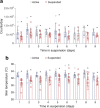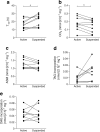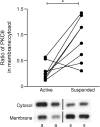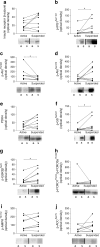One-leg inactivity induces a reduction in mitochondrial oxidative capacity, intramyocellular lipid accumulation and reduced insulin signalling upon lipid infusion: a human study with unilateral limb suspension
- PMID: 32185462
- PMCID: PMC7228997
- DOI: 10.1007/s00125-020-05128-1
One-leg inactivity induces a reduction in mitochondrial oxidative capacity, intramyocellular lipid accumulation and reduced insulin signalling upon lipid infusion: a human study with unilateral limb suspension
Abstract
Aims/hypothesis: Physical inactivity, low mitochondrial function, increased intramyocellular lipid (IMCL) deposition and reduced insulin sensitivity are common denominators of chronic metabolic disorders, like obesity and type 2 diabetes. Yet, whether low mitochondrial function predisposes to insulin resistance in humans is still unknown.
Methods: Here we investigated, in an intervention study, whether muscle with low mitochondrial oxidative capacity, induced by one-legged physical inactivity, would feature stronger signs of lipid-induced insulin resistance. To this end, ten male participants (age 22.4 ± 4.2 years, BMI 21.3 ± 2.0 kg/m2) underwent a 12 day unilateral lower-limb suspension with the contralateral leg serving as an active internal control.
Results: In vivo, mitochondrial oxidative capacity, assessed by phosphocreatine (PCr)-recovery half-time, was lower in the inactive vs active leg. Ex vivo, palmitate oxidation to 14CO2 was lower in the suspended leg vs the active leg; however, this did not result in significantly higher [14C]palmitate incorporation into triacylglycerol. The reduced mitochondrial function in the suspended leg was, however, paralleled by augmented IMCL content in both musculus tibialis anterior and musculus vastus lateralis, and by increased membrane bound protein kinase C (PKC) θ. Finally, upon lipid infusion, insulin signalling was lower in the suspended vs active leg.
Conclusions/interpretation: Together, these results demonstrate, in a unique human in vivo model, that a low mitochondrial oxidative capacity due to physical inactivity directly impacts IMCL accumulation and PKCθ translocation, resulting in impaired insulin signalling upon lipid infusion. This demonstrates the importance of mitochondrial oxidative capacity and muscle fat accumulation in the development of insulin resistance in humans.
Trial registration: ClinicalTrial.gov NCT01576250.
Funding: PS was supported by a 'VICI' Research Grant for innovative research from the Netherlands Organization for Scientific Research (Grant 918.96.618).
Keywords: Fat oxidation; Insulin resistance; Intramyocellular lipid content; Mitochondrial function; Mitochondrial oxidative capacity; Physical inactivity; Unilateral lower-limb suspension.
Figures







Similar articles
-
Impaired in vivo mitochondrial function but similar intramyocellular lipid content in patients with type 2 diabetes mellitus and BMI-matched control subjects.Diabetologia. 2007 Jan;50(1):113-20. doi: 10.1007/s00125-006-0475-1. Epub 2006 Nov 9. Diabetologia. 2007. PMID: 17093944
-
Markers of skeletal muscle mitochondrial function and lipid accumulation are moderately associated with the homeostasis model assessment index of insulin resistance in obese men.PLoS One. 2013 Jun 12;8(6):e66322. doi: 10.1371/journal.pone.0066322. Print 2013. PLoS One. 2013. PMID: 23776659 Free PMC article.
-
Endurance training modulates intramyocellular lipid compartmentalization and morphology in skeletal muscle of lean and obese women.J Clin Endocrinol Metab. 2013 Dec;98(12):4852-62. doi: 10.1210/jc.2013-2044. Epub 2013 Sep 30. J Clin Endocrinol Metab. 2013. PMID: 24081737
-
Intramuscular lipid metabolism, insulin action, and obesity.IUBMB Life. 2009 Jan;61(1):47-55. doi: 10.1002/iub.142. IUBMB Life. 2009. PMID: 18839419 Free PMC article. Review.
-
Metabolic flexibility and insulin resistance.Am J Physiol Endocrinol Metab. 2008 Nov;295(5):E1009-17. doi: 10.1152/ajpendo.90558.2008. Epub 2008 Sep 2. Am J Physiol Endocrinol Metab. 2008. PMID: 18765680 Free PMC article. Review.
Cited by
-
Single-leg disuse decreases skeletal muscle strength, size, and power in uninjured adults: A systematic review and meta-analysis.J Cachexia Sarcopenia Muscle. 2023 Apr;14(2):684-696. doi: 10.1002/jcsm.13201. Epub 2023 Mar 7. J Cachexia Sarcopenia Muscle. 2023. PMID: 36883219 Free PMC article. Review.
-
Chicken or Egg? Mitochondrial Phospholipids and Oxidative Stress in Disuse-Induced Skeletal Muscle Atrophy.Antioxid Redox Signal. 2023 Feb;38(4-6):338-351. doi: 10.1089/ars.2022.0151. Antioxid Redox Signal. 2023. PMID: 36301935 Free PMC article. Review.
-
Positive Effects of Physical Activity on Insulin Signaling.Curr Issues Mol Biol. 2024 May 30;46(6):5467-5487. doi: 10.3390/cimb46060327. Curr Issues Mol Biol. 2024. PMID: 38920999 Free PMC article. Review.
-
Insights into the development of insulin resistance: Unraveling the interaction of physical inactivity, lipid metabolism and mitochondrial biology.Front Physiol. 2023 Apr 20;14:1151389. doi: 10.3389/fphys.2023.1151389. eCollection 2023. Front Physiol. 2023. PMID: 37153211 Free PMC article. Review.
-
Adipose tissue macrophage populations and inflammation are associated with systemic inflammation and insulin resistance in obesity.Am J Physiol Endocrinol Metab. 2021 Jul 1;321(1):E105-E121. doi: 10.1152/ajpendo.00070.2021. Epub 2021 May 17. Am J Physiol Endocrinol Metab. 2021. PMID: 33998291 Free PMC article.
References
Publication types
MeSH terms
Substances
Associated data
Grants and funding
LinkOut - more resources
Full Text Sources
Medical

